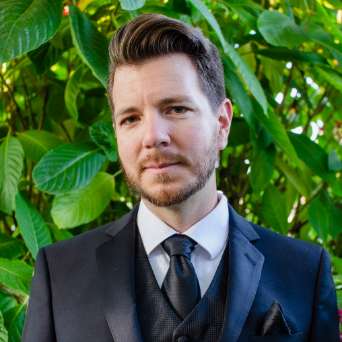Aida typifies all that is grand about opera. Its exotic setting, majestic music, and dramatic love triangle can make for an evening unique among performing arts events. It’s not a bad way to close an opera season either. San Diego Opera did so on Saturday, capping a uniformly satisfying season with Zandra Rhodes’ vibrant production that was refreshing and at times thrilling.
Most of the evening’s thrills were from the most important singer onstage, Aida herself. The last-minute Met debut of soprano Latonia Moore is the stuff of which legends are made. While not a legend yet, Moore is understandably lauded for her performance of Aida and is on the cusp of becoming something very special indeed. She is a magnet onstage, drawing every eye to her fully-committed, corporeal involvement in the part, even when not singing. It is quite unfair to mention Leontyne Price in any review of a current Aida, but there is an uncanny vocal resemblance here. Moore doesn’t sing with Price’s uniformity of sound, particularly in her middle voice, which can flutter a bit, but her top notes are thrilling, with a similar crying edge in the sound that effortlessly carries the voice above the ensemble. Moore’s soprano voice has edge and fire; in some ways she’s a throwback with her use of portamento and range of expression. She holds back nothing. Moore’s phrasing is graceful and her pianissimos effortless. Her “Ritorna vincitor” was tortured and highly sympathetic. Her “O patria mia” was expressive and dynamic. Her high C was spot-on and shimmering.
Still, it’s not a completely polished instrument. She lacks some power in her middle voice and tends to spread through the upper passaggio. But what is already well-established in her voice is often breathtaking. She has a chance to be a star as Aida with a unique color of sound and intelligence as a singing actor. A word to the wise: keep an eye on Latonia Moore.
As her rival Amneris, mezzo-soprano Jill Grove took some time to ease into her part, but turned in a gripping fourth act, despite reaching her vocal limits a few times. Grove’s isn’t a particularly broad mezzo voice, but it has carry. She was an appropriately menacing Amneris but one who was sympathetic in her unrequited torment.
Veteran bass-baritone Mark S. Doss (Amonasro) sang with an imposing presence and stentorian sound. His sound became slightly constricted towards the top of his tessitura, but he was convincing nonetheless. His confrontation with Aida in the third act was frightening in intensity. Italian tenor Walter Fraccaro was a wooden actor and sang with a shouty sound. He tended to over-modify his vowels beyond recognition and downshift into his high notes. They were powerful, to be sure, but he was quite one-dimensional in sound, lacking in lyric aplomb. The treacherous “Celestia Aida” was unfortunately brutish.
The supporting cast was satisfying led by bass Reinhard Hagen as Ramfis who sang with a dark but pliable sound. Ashraf Sewailam’s King was sung with a slightly wooly, but effective, sound. Greg Fedderly sang a good messenger, even if it were a slightly older sound is typical. Priti Gandhi sang alluringly as the Priestess.
Conductor Daniele Callegari led a well-paced performance, taking some of the choruses noticeably swifter than usual. Still, the music never felt rushed and it breathed quite well. The orchestra and chorus responded well, playing and singing with raw power, but never sounding overmatched. The big choral climaxes were spectacular. Textures during the delicate Nile scene were clear and the tomb scene was caressed to its tender conclusion.
The sets and costumes were bright and flashy, but managed to avoid garishness. The costume patterns were thoughtfully created and avoided tackiness. Turquoises, oranges, and yellows brightly occupied the stage. The sets, while intriguing in design, were often shallow and two-dimensional, most notably in the second scene of Act II. Choreographer Kenneth von Heidecke’s ballets were traditional and well-executed for the most part. The all-male ballet in Amneris’ apartment was the most thrilling and cleverly done.
Director Andrew Sinclair did a fine job of highlighting the relationships between the characters. A short on-stage play during the prelude added to the believability of the situation. Some of the larger scenes were a bit troublesome, however. The triumphal march was long on dancing and short on processing. The stage was very shallow and looked somewhat cramped. To cap it off, Radames entered drawn by a large elephant puppet. The scene seemed like a missed opportunity, which is too bad considering how well it was done by the chorus and orchestra. The tomb scene was somewhat awkward with a melodramatically suffocating Aida and an only slightly elevated Amneris appearing directly behind the two lovers in an already smaller tableaux.
In any case, there was much to enjoy here. This was a vibrant Aida to behold and, as notoriously difficult as this piece is to cast, San Diego Opera knocked one out of the park with Latonia Moore. Despite a few shortcomings, it was a thankfully refreshing production and committed performance, reminding me why Aida can be such a special evening of music.




